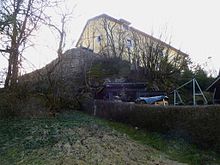Greisingberg Castle
The Greisingberg castle located in the district Greisingberg the community Pregarten in the district of Freistadt in the country Upper Austria (Greisingberg no. 1).
history
The Greusnich family are mentioned in a document with Arnold de Greiczing in 1160 and 1170, but these are located at the Groissing headquarters in Arbing . The last of this family might have been Perthold von Greusnich, named in 1326. "Grezcinc" is said to have been a Liechtenstein fief.
Greisingberg was documented in 1427 in the possession of Peter Greisenegger and after his death in 1574 it came to the Kienast family by marriage. While Reichenstein Castle came from the possession of the Liechtenstein family to the knight Christoph Haim in 1567, the Liechtenstein family sold Greisingberg in 1582 to Georg Gundaker von Neuhaus. His widow Scholastika von Hoheneck ceded Greisingberg to Reichart von Sprinzenstein, the owner of Reichenstein at the time, in 1633.
In a "casual rollover or attack", the aristocratic country estate Greisingberg was advertised for sale in 1729. In a detailed description it was pointed out that Mr. Georg Gundaker, Baron von Neuhaus, had rebuilt this manorial country estate “and occasionally set it up”, had built a forge with the associated blacksmithing and a courtyard tavern with a right to the right that the eight fields of the The farm is productive and the magnificent orchards are mostly pregnant, the forests that have grown up offer timber, the little brook holds trout, gobies and carp and that the six housed subjects are useful. In 1729 the court office demanded taxes from the Greisingberg estate and from 17½ fireplaces, including from Adam Pfännl (Pfahnl) from the Gut an der Greilenhueb, from Thomas Schößl on the Puchenhofstatt (Greisingberg No. 10, with over 10 yokes), from Michael Gusenpauer from the Hofstatt am Stannegg (Greisingberg No. 9, with a good 5 Joch Grund), but also already from Thobias Schmit from Mayerhof am Greysingberg and Reichardt Stummvoll from Tafehrn and parcel justice on Greysingberg. Gundaker Thomas Starhemberg finally acquired the Greisingberg estate, which was incorporated into the Reichenstein rulership, for 113,000 guilders (and 1200 guilders on loan) on December 31, 1729 and combined it with Schloss Haus near Wartberg ob der Aist .
Sigmund Rittmannsperger, bourgeois master brewer in Pregarten, bought the Schlössl in Greisingberg including 100 square fathoms Schlossanger for 110 guilders in the Starhemberg office of Schloss Haus on August 12, 1799 at 12 noon. However, the deed of sale completed on August 27, 1799 by the nurse Franz Angerer was not ratified under state law until September 13, 1807, since the master brewer Rittmannsperger died soon after the purchase. Josef Rittmannsperger, a bourgeois iron merchant in the Pregarten market, was finally able to take possession of the Schlössl, inherited in his father's will, on February 6, 1813 in the land register.
With the purchase agreement of January 31, 1929, the Starhembergischer Schlössl in Greisingberg became a community-owned poor house of the community of Pregartdorf for the purpose of housing their community poor. As a result of the amalgamation of municipalities in 1938, ownership of the poor house was transferred to the market town of Pregarten on June 5, 1942. Anna Raab bought this house on August 21, 1942 and handed it over to her daughter Anna and son-in-law Johann Buchberger on September 24, 1964. In December 2002 the house was handed over to the daughter Beate Moustakakis-Buchberger. Today the castle building is privately owned by the Moustakakis family, has been renovated and is inhabited.
description

Vischer's copper engraving from 1674 shows the Schlössl (Greisingberg No. 1), part of the Meierhof (Greisingberg No. 2) and the associated farm tavern (Greisingberg No. 3) as an attractive aristocratic country residence. Diagonally across from the entrance was a square tower that served as a stable up to half the height of the roof.
The Schmiedhäusl (Greisingberg No. 5, owned by Hans Zäller in 1729), the Reiterhäusl (Greisingberg No. 4) and the Höcklhäusl (Greisingberg No. 6, the property of the mason Christoph Höckler) also belonged to the manor.
Greisingberg today

The little castle stands on a ridge high above the Waldaist . Today it is a hook-shaped, two-wing, two-story building. The remaining structure consists of a high wall, which forms the outer front of a residential and farm building attached to the courtyard. The entrance on the courtyard side has lost its original gateway. The onion dome seen in the engraving by Georg Matthäus Vischer no longer exists.
In the anteroom there are supposed to be ribbed vaults from the 17th century. The previously existing trench in front of the tower has been leveled. A corbel used to be preserved on the outer wall to the Aist, which probably used to belong to a curb, but has now been lost. To the east of the castle there may be remains of late medieval walls. The castle is secured against the steep slope below with a wall.
The Meierhof , which formerly belonged to the Greisingberg rule, was separated from the manor house in the 18th century. Today it stands below the castle and is a farm.
literature
- Norbert Grabherr : Castles and palaces in Upper Austria. A guide for castle hikers and friends of home . 3. Edition. Oberösterreichischer Landesverlag, Linz 1976, ISBN 3-85214-157-5 .
- Georg Grüll : Castles and palaces in Upper Austria, Volume 1: Mühlviertel . Birken-Verlag, Vienna 1962.
- Christian K. Steingruber : A critical consideration of the historical-topographical manual by Norbert Grabherr . Upper Austrian Provincial Archives , Linz 2019.
Web links
Coordinates: 48 ° 20 '45 " N , 14 ° 33' 32.7" E







